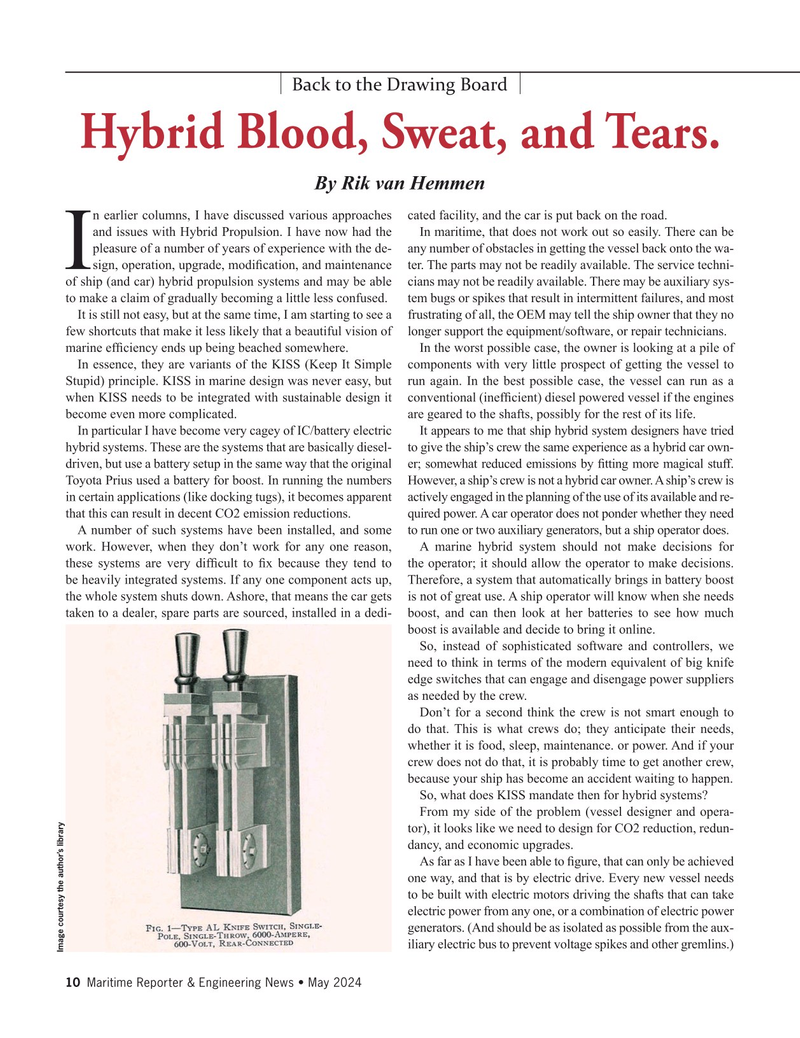
Page 10: of Maritime Reporter Magazine (May 2024)
Read this page in Pdf, Flash or Html5 edition of May 2024 Maritime Reporter Magazine
Back to the Drawing Board
Hybrid Blood, Sweat, and Tears.
By Rik van Hemmen n earlier columns, I have discussed various approaches cated facility, and the car is put back on the road.
and issues with Hybrid Propulsion. I have now had the In maritime, that does not work out so easily. There can be pleasure of a number of years of experience with the de- any number of obstacles in getting the vessel back onto the wa-
Isign, operation, upgrade, modi? cation, and maintenance ter. The parts may not be readily available. The service techni- of ship (and car) hybrid propulsion systems and may be able cians may not be readily available. There may be auxiliary sys- to make a claim of gradually becoming a little less confused. tem bugs or spikes that result in intermittent failures, and most
It is still not easy, but at the same time, I am starting to see a frustrating of all, the OEM may tell the ship owner that they no few shortcuts that make it less likely that a beautiful vision of longer support the equipment/software, or repair technicians. marine ef? ciency ends up being beached somewhere. In the worst possible case, the owner is looking at a pile of
In essence, they are variants of the KISS (Keep It Simple components with very little prospect of getting the vessel to
Stupid) principle. KISS in marine design was never easy, but run again. In the best possible case, the vessel can run as a when KISS needs to be integrated with sustainable design it conventional (inef? cient) diesel powered vessel if the engines become even more complicated. are geared to the shafts, possibly for the rest of its life.
In particular I have become very cagey of IC/battery electric It appears to me that ship hybrid system designers have tried hybrid systems. These are the systems that are basically diesel- to give the ship’s crew the same experience as a hybrid car own- driven, but use a battery setup in the same way that the original er; somewhat reduced emissions by ? tting more magical stuff.
Toyota Prius used a battery for boost. In running the numbers However, a ship’s crew is not a hybrid car owner. A ship’s crew is in certain applications (like docking tugs), it becomes apparent actively engaged in the planning of the use of its available and re- that this can result in decent CO2 emission reductions. quired power. A car operator does not ponder whether they need
A number of such systems have been installed, and some to run one or two auxiliary generators, but a ship operator does.
work. However, when they don’t work for any one reason, A marine hybrid system should not make decisions for these systems are very dif? cult to ? x because they tend to the operator; it should allow the operator to make decisions. be heavily integrated systems. If any one component acts up, Therefore, a system that automatically brings in battery boost the whole system shuts down. Ashore, that means the car gets is not of great use. A ship operator will know when she needs taken to a dealer, spare parts are sourced, installed in a dedi- boost, and can then look at her batteries to see how much boost is available and decide to bring it online.
So, instead of sophisticated software and controllers, we need to think in terms of the modern equivalent of big knife edge switches that can engage and disengage power suppliers as needed by the crew.
Don’t for a second think the crew is not smart enough to do that. This is what crews do; they anticipate their needs, whether it is food, sleep, maintenance. or power. And if your crew does not do that, it is probably time to get another crew, because your ship has become an accident waiting to happen.
So, what does KISS mandate then for hybrid systems?
From my side of the problem (vessel designer and opera- tor), it looks like we need to design for CO2 reduction, redun- dancy, and economic upgrades.
As far as I have been able to ? gure, that can only be achieved one way, and that is by electric drive. Every new vessel needs to be built with electric motors driving the shafts that can take electric power from any one, or a combination of electric power generators. (And should be as isolated as possible from the aux- iliary electric bus to prevent voltage spikes and other gremlins.)
Image courtesy the author’s library 10 Maritime Reporter & Engineering News • May 2024
MR #5 (1-17).indd 10 5/3/2024 9:49:38 AM

 9
9

 11
11
